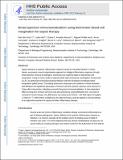Broad spectrum immunomodulation using biomimetic blood cell margination for sepsis therapy
Author(s)
Hou, Han Wei; Wu, Lidan; Amador-Munoz, Diana P.; Vera, Miguel Pinilla; Coronata, Anna; Englert, Joshua A.; Levy, Bruce D.; Baron, Rebecca M.; Han, Jongyoon; ... Show more Show less
DownloadBroad spectrum.pdf (2.016Mb)
OPEN_ACCESS_POLICY
Open Access Policy
Creative Commons Attribution-Noncommercial-Share Alike
Terms of use
Metadata
Show full item recordAbstract
Sepsis represents a systemic inflammatory response caused by microbial infection in blood. Herein, we present a novel comprehensive approach to mitigate inflammatory responses through broad spectrum removal of pathogens, leukocytes and cytokines based on biomimetic cell margination. Using a murine model of polymicrobial sepsis induced by cecal ligation and puncture (CLP), we performed extracorporeal blood filtration with the developed microfluidic blood margination (μBM) device. Circulating bacteremia, leukocytes and cytokines in blood decreased post-filtration and significant attenuation of immune cell and cytokine responses were observed 3–5 days after intervention, indicating successful long-term immunomodulation. A dose-dependent effect on long-term immune cell count was also achieved by varying filtration time. As proof of concept for human therapy, the μBM device was scaled up to achieve ∼100-fold higher throughput (∼150 mL h⁻¹). With further multiplexing, the μBM technique could be applied in clinical settings as an adjunctive treatment for sepsis and other inflammatory diseases.
Date issued
2016-01Department
Massachusetts Institute of Technology. Department of Biological Engineering; Massachusetts Institute of Technology. Department of Electrical Engineering and Computer Science; Massachusetts Institute of Technology. Research Laboratory of ElectronicsJournal
Lab on a Chip
Publisher
Royal Society of Chemistry, The
Citation
Hou, Han Wei, et al. “Broad Spectrum Immunomodulation Using Biomimetic Blood Cell Margination for Sepsis Therapy.” Lab on a Chip 16, 4 (2016): 688–699 © 2016 The Royal Society of Chemistry
Version: Author's final manuscript
ISSN
1473-0197
1473-0189